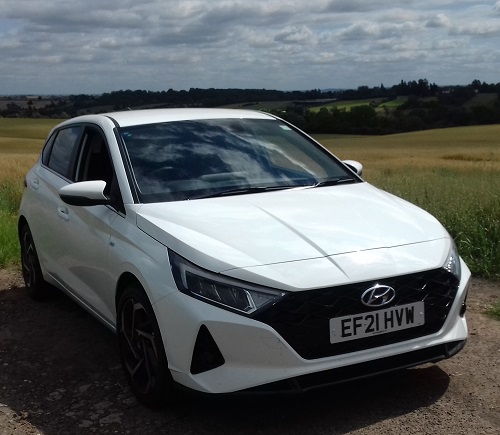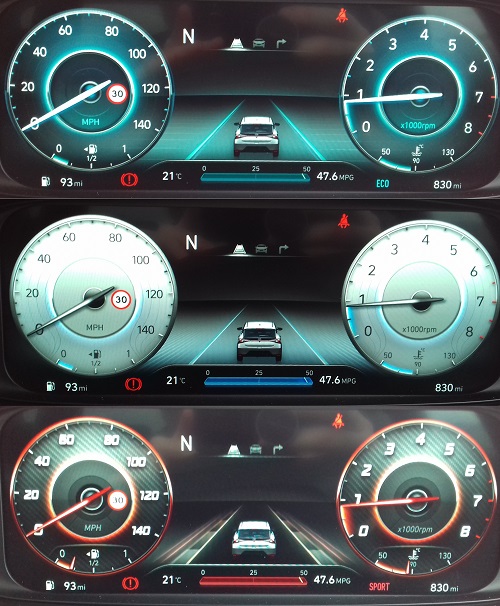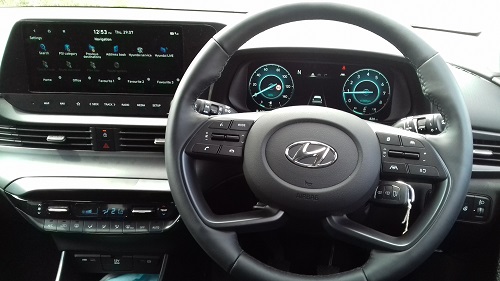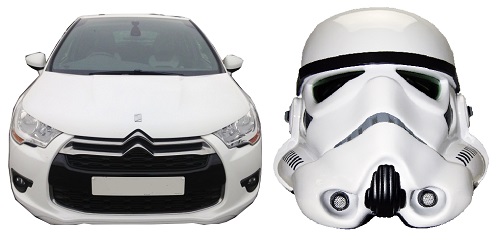Too many nags, not enough horses
It’s a bad sign when you start looking for reasons to dislike a car, yet that’s where I am with the Hyundai i20.
I had use of this mild hybrid for a couple of weeks, collecting it with just 53 miles on the clock, and frankly was happy to give it back again.

First, the good points. I quite like the lines of the thing, although my co-pilot thought it a bit masculine. I can live with that. It’s well equipped, and it demonstrated impressive economy.
None of this is enough to overcome the less good points, which begin with simply climbing in. The car plays an irritatingly chirpy little six-note melody as a greeting, and then six further alarm beeps for absolutely no reason at all. It’s a damned cacophony and I haven’t even got it running yet.
Nor will I, until I press both clutch and brake pedals. Really? Both of them? Even then a turn of the key is followed by… nothing. It pauses for perhaps a second, just long enough to make you think it’s broken, before firing up. Not a great first impression.
There is a fashion in vehicle design to overcommunicate with drivers, and Hyundai has embraced that vogue. The right hand instrument panel dial, normally the tachometer, readily converts to a nag screen with text messages to tell you what the car doesn’t like about your driving.
This starts with the clutch/brake thing, includes admonitions to keep your hands on the wheel, and reaches its peak with the hideous lane assist feature. More on that shortly.
The interior space is good for a car in this class, and certainly there is more passenger room than a Ford Fiesta or Vauxhall Astra, both of which I’ve driven in the last month. The same cannot be said for the boot, which was so small even my spaniel (always eager to go for a ride) was reluctant to jump in.
The briefcase-sized Li-ion polymer battery lives under the boot floor in the space where the spare wheel should be. Yes, another car with just an aerosol ‘puncture repair kit’ rather than an actual wheel – another regrettable trend in modern motoring.
The boot release is the fiddliest thing I’ve come across this year: a small button under a rubber diaphragm, under the lip of the bodywork. It’s hard to find, hard to press, and I bet the rubber will perish or be punctured by fingernails within a few years.
When adequate isn’t good enough
Once underway, the three-cylinder one-litre turbocharged engine is just about adequate most of the time. But when it isn’t, it really isn’t.
The age-old problem of turbo lag is made worse by the car’s continual encouragement to change up a gear or two, all presumably in pursuit of lower fuel consumption.

This is yet another way the Hyundai nags its driver. A superfluous digital gear indicator is accompanied by the car’s suggestion of which gear you ought to be in – inevitably a higher one.
Even going uphill in third, at about 1500rpm, it says you really ought to be in fourth. Never mind that this would be a good way to stall, the car knows better and wants to tell you all about it.
I did stall it once, and it wasn’t pleasant. I botched a steep hill start after a friendly Mercedes pulled up intimately close behind me. I’m used to a little more torque – as any modest car might have – but the weedy Hyundai couldn’t rescue me from the mess I’d made, and gave up.
Attempting a quick restart, and remembering about the clutch and brake, I was rewarded only with a nag screen message to also put the gearbox into neutral.
I may have used some naughty words at this point.
The engine sounds surprisingly rough by modern standards, and could be mistaken for a diesel. It pushes the car along without much excitement but managed both the urban crawl and motorway cruises perfectly well.
That lack of pick-up leads to the occasional sphincter-clenching moment though, such as when turning across oncoming traffic. Sometimes you just need a bit more than this thing wants to deliver.
And sometimes it decides to deliver nothing at all. A curious and disconcerting feature is Hyundai’s ‘sailing’ mode, where the petrol engine shuts down in the cruise and the electric motor takes over.

This is alarming at first, and my experience was that the car’s speed gradually decreased – prompting a little more pressure from the right foot, in turn restarting the petrol engine.
It all seems a rather odd way to save fuel. I’d much rather it had an urban driving setting, using electric power in stop-start traffic and low speeds.
It’s trying to kill me
The ride quality is nothing special: clunky, imprecise, and somehow soulless. What makes it worse – far, far worse – is the lane assistance feature. Now, I’m not a fan of these on any car, and reckon they are actually dangerous. If you haven’t experienced it, try not to.
When the vehicle decides you are straying from your appointed lane, by reading the lane markings, it nudges the steering back onto the course it thinks you should be on.
It isn’t autodrive, it’s just the not-very-bright artificial intelligence making the steering wheel turn at its discretion. And it is ghastly.
The i20’s version of this comes on by default, and (despite what the owner’s manual claims) comes back on with every restart. A long hold on a steering wheel button will disable it, but I found nothing in the vehicle settings that kept it turned off.
Here’s a tip: when scrolling the too-many options on the huge infotainment screen, resist any temptation to make use of the nominated driver settings. Straying out of ‘guest’ mode happens to turn the speedo to km/hr rather than mph.
Predictably I had not noticed this when playing with the settings, until I set off down a dual carriageway with tightly-enforced average speed cameras. Cue a bit of emergency mental arithmetic.

That screen, 10.25 inches across, is clear and bright and is nicely integrated into the dashboard – unlike some (I’m looking at you, Tesla and VW) where screens appear glued on as an afterthought.
It’s not the easiest to navigate, though, with far too many options and too-small touchscreen hotspots. Satnav graphics are nice, but the display will only show one function at a time – a shocking waste of all that lovely visual real estate.
Other controls are an ergonomic mess. I think I counted 40 actual buttons, on four panels plus the steering wheel, and a further handful on the steering column stalks. It’s quite possible I overlooked some, given how dark and gloomy it is inside.
Altogether then, the Hyundai i20 48V mild hybrid has sharp styling, if you like that sort of thing, good interior space, and good economy. I did nearly 800 miles in it, including a couple of motorway runs, some town driving and quite a lot of A- and B-roads. It returned 47.5mpg overall, which ain’t bad.
On the negative side, the i20 delivers an unrewarding driving experience with occasional moments of terror, and an overall poor user experience. Not for me, thanks all the same.



